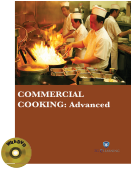Hotel and Restaurant Management

Commercial Cooking: Advanced comprehends various diverse practical and visual skills with knowledge of specialized materials and techniques. Commercial cooking is simply cooking for other people, provided that they will be compensated for the service rendered. Examples are cooking in restaurants, cafeterias, canteens etc. This book will introduce the knowledge and skills for those studying and/or working in hotels, motels, restaurants, clubs, etc.
About this Book
The information in this book covers basic to core competencies that a person must achieve to plan, prepare and present various hot and cold products, including specialized food items, specialty cuisines and quantity foods and supervise a small team of cooks for guests in hotels, motels, restaurants, clubs, canteens, resorts, luxury liners and cruise ships within the company’s acceptable standards.
About the Commercial Cooking Industry
Culinary art, in which culinary means “related to cooking”, is the art of the preparation, cooking and presentation of food, usually in the form of meals. People working in this field – especially in establishments such as restaurants – are commonly called “chefs” or “cooks”, although, at its most general, the terms “culinary artist” and “culinarian” are also used. Culinarians are required to have knowledge of food science, nutrition and diet and are responsible for preparing meals that are as pleasing to the eye as well as to the palate. After restaurants, their primary places of work include delicatessens and relatively large institutions such as hotels and hospitals. Restaurants, hotels and other food service industries may often employ three distinct types of employees -- chefs, cooks, and food preparation workers. Chefs may responsible for directing the activities of other kitchen workers, menu planning, recipe creation, food and supply ordering, and some specific cooking duties. They are typically the most senior members of the staff. Cooks may responsible for the day to day food preparation at the restaurant or facility. Depending on the size of the facility, there may be several cooks, each responsible for a different part of the menu, or a different type of food. For example, there are fry cooks, vegetable cooks, pastry cooks, and other specialties. Food Preparation Workers may work under the supervision of chefs and cooks, and typically perform less skilled duties. For example, they may chop vegetables, prepare salads, and prepare materials used by the restaurant’s chefs and cooks. In order to work as a head cook or chef, one should complete a formal training program. A chef may receive certification that demonstrates to an employer that he or she has achieved a certain level of proficiency. They must be strong leaders and have excellent communication and time management skills.